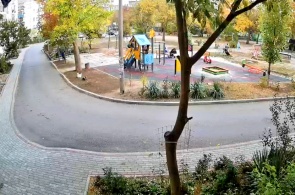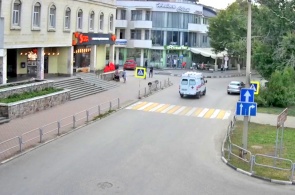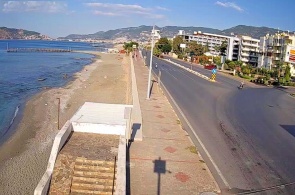Feodosia has an ancient history. This city was ruled by representatives of the most diverse peoples. And each period of the city chronicle left behind a huge variety of religious buildings.
The center of Orthodoxy in Feodosia is the Church of the Holy Great Martyr Catherine. The construction was laid on St. Catherine's Day, April 21, 1892. It is noteworthy that on the same day, 1.5 years earlier, the future queen of the Russian Empire, Catherine the Great, was born, under whom the Crimea for the first time in its history became part of Russia.
The temple was built on charitable donations, and the residents of Feodosia themselves took part in its construction.
The church has snow-white facades, small blue domes in the corners and a central gilded dome. On all sides of the wall there are green decorative kokoshniks. The entrance to the temple is decorated with statues of angels.
The elegant decor and pseudo-Russian style make the Catherine Church look like an old tower. The interior decoration of the temple amazes with the abundance of decor. Thanks to the many windows through which a lot of sunlight passes, the rooms are well lit.
One of the oldest churches in the city is the Armenian temple Surb Sarkis, consecrated in the name of St. Sergius. Experts still have not come to a consensus on the date of construction of the building. According to the original version, the temple was built in the XIV century. But later, scientists began to lean towards the idea that it was erected even earlier, in the 9th or 10th century.
According to legend, the military leader Sergius (Sarkis) died a painful death for his religious views at the hands of a Byzantine ruler.
It is noteworthy that at the end of the century before last, there was a severe fire in the temple. The money for the restoration of the Armenian shrine was donated by Ivan Aivazovsky, known for his charity. By the way, the real name of the artist is Ayvazyan. The marine painter who became famous in his youth had Armenian roots.
Surb Sarkis was closed during the reign of the Bolsheviks. Although, in comparison with other religious buildings, this temple is more fortunate. There was a museum here, so the building has been well preserved to this day. The object was returned to the Armenian community in the 70s of the last century.
The structure, like many Armenian temples, is made of rough stone. The facades are decorated with stone crosses and ornaments. Indoors are very ascetic. Among the few decorations are surviving fragments of wall paintings and stone carvings.
The center of Orthodoxy in Feodosia is the Church of the Holy Great Martyr Catherine. The construction was laid on St. Catherine's Day, April 21, 1892. It is noteworthy that on the same day, 1.5 years earlier, the future queen of the Russian Empire, Catherine the Great, was born, under whom the Crimea for the first time in its history became part of Russia.
The temple was built on charitable donations, and the residents of Feodosia themselves took part in its construction.
The church has snow-white facades, small blue domes in the corners and a central gilded dome. On all sides of the wall there are green decorative kokoshniks. The entrance to the temple is decorated with statues of angels.
The elegant decor and pseudo-Russian style make the Catherine Church look like an old tower. The interior decoration of the temple amazes with the abundance of decor. Thanks to the many windows through which a lot of sunlight passes, the rooms are well lit.
One of the oldest churches in the city is the Armenian temple Surb Sarkis, consecrated in the name of St. Sergius. Experts still have not come to a consensus on the date of construction of the building. According to the original version, the temple was built in the XIV century. But later, scientists began to lean towards the idea that it was erected even earlier, in the 9th or 10th century.
According to legend, the military leader Sergius (Sarkis) died a painful death for his religious views at the hands of a Byzantine ruler.
It is noteworthy that at the end of the century before last, there was a severe fire in the temple. The money for the restoration of the Armenian shrine was donated by Ivan Aivazovsky, known for his charity. By the way, the real name of the artist is Ayvazyan. The marine painter who became famous in his youth had Armenian roots.
Surb Sarkis was closed during the reign of the Bolsheviks. Although, in comparison with other religious buildings, this temple is more fortunate. There was a museum here, so the building has been well preserved to this day. The object was returned to the Armenian community in the 70s of the last century.
The structure, like many Armenian temples, is made of rough stone. The facades are decorated with stone crosses and ornaments. Indoors are very ascetic. Among the few decorations are surviving fragments of wall paintings and stone carvings.
More details
Camera with a view of the Chernobyl Square in Feodosia (Crimea). The lens captures a spacious, picturesque area, which has become one of 5 public locations, landscaped within the framework of the regional and all-Russian projects "Formation of a comfortable urban environment" and "Housing and urban environment". The broadcast is broadcast in real time.
Feodosiya, Crimea
11.11.21
Webcam with a view of the adjoining territory at 12 Starshinova Street in Feodosia (Crimea). The lens captures parking for cars and a cozy front garden. Behind it there is a sports ground, which appeared here relatively recently, as part of the state improvement program. The broadcast is carried out in real time.
Feodosiya, Crimea
10.11.21
Live webcam is installed at Simferopol highway, 1 in Feodosia (Crimea). The lens of the device captures a fragment of a modern playground and the adjoining territory, which was recently landscaped within the framework of the state program. The broadcast is carried out in real time.
Feodosiya, Crimea
09.11.21
The webcam is installed in the courtyard of the house number 28A on the Crimean street in Feodosia (Crimea). The lens covers a landscaped area near the house, which was reconstructed within the framework of the state program. Here is the MFC, tax office, post office. The broadcast is carried out in real time
Feodosiya, Crimea
07.11.21
Camera overlooking the Monument to St. Andrew the First-Called in Feodosia. The monument is located next to Karl Marx Street. The lens captures a recently landscaped square and a monument representing a cult sculptural image. Nearby there is a parking lot, an extensive public garden. The broadcast is broadcast in real time.
Feodosiya, Crimea
06.11.21
The camera is located in the courtyard of the house number 42 on the street. Gorky in Feodosia (Crimea). The lens captures a landscaped house area with a modern playground, cobbled sidewalks and flower beds. The landscaping of the courtyard took place quite recently, and now you can watch the renovated recreational area in real time.
Feodosiya, Crimea
06.11.21
The device is installed at house No. 5 on Zheleznodorozhnaya Street in Feodosia (Crimea). The lens captures a cozy adjoining territory with a playground and flower beds, which was recently landscaped within the framework of the state program. Today, in real time, you can observe the well-groomed courtyard and keep abreast of what is happening in the distant sunny town.
Feodosiya, Crimea
05.11.21
The camera overlooks the monument to the hero of the Caucasian War of the 19th century - General Pyotr Kotlyarevsky (Feodosia, Crimea). The monument adorns the embankment of the city, next to the house where the military leader lived, who did not lose a single battle. The monument is an equestrian sculpture placed on a granite pedestal. There is a spacious area around the monument.
Feodosiya, Crimea
07.10.21
Live webcam is positioned in the Feodosia park "Yubileiny" (Republic of Crimea). The lens covers a spacious, well-maintained alley with flower beds and bushes. In the background you can see the Good Genius fountain, which was created in honor of I.K. Aivazovsky, who bought a land plot for the city, on which a fresh water source was located.
Feodosiya, Crimea
07.10.21
The camera is positioned in the Crimean city of Feodosia. The lens of the device captures a large store "Novy Svet" and the adjacent territory. The object is located on the street. Nazukin 9/1. There is a shop, cafe and hotel here. The view opens from the side of the road. The broadcast is broadcast in real time.
Feodosiya, Crimea
06.10.21
Webcam overlooking the monument to I.K. Aivazovsky, near the gallery founded by the artist (Feodosia, Crimea). The lens covers the spacious street, the museum building and the monument itself. The gallery was opened in 1880. It includes 417 paintings by Aivazovsky, representing the most extensive collection of paintings by the marine painter in the world. The broadcast can be watched in real time.
Feodosiya, Crimea
06.10.21
The camera is positioned in the resort city of Feodosia (Republic of Crimea). The paratroopers' embankment gets into the lens of the device. In the background you can see the cargo cranes of the Feodosia port and the Ferris wheel. On the left, the overview covers the Black Sea. The broadcast is carried out in real time.
Feodosiya, Crimea
06.10.21
The webcam is installed in the city of Feodosia (Republic of Crimea) with a view of the city port and the lighthouse. The lens covers the strip of the beach and the embankment adjacent to it. The port's cargo cranes and a lighthouse are visible in the background. There is also a Ferris wheel with amazing views of the sea and urban surroundings. The broadcast is conducted online.
Feodosiya, Crimea
05.10.21
Camera with a view of the station square in Feodosia (Crimea). The lens captures a spacious platform, in the background of which you can see the one-story building of the railway station. Nearby there is a park and a city embankment, numerous cafes and museums. The broadcast is broadcast in real time.
Feodosiya, Crimea
05.10.21
Camera overlooking General Gorbachev Street in Feodosia (Republic of Crimea). The overview covers a large pedestrian zone, an abundance of shops and cafes. Here you can order a pleasure van or take a walk. The angle opens from the side of the 2nd crossing. The broadcast is carried out in real time.
Feodosiya, Crimea
05.10.21
popular camerasshow all
Sultanahmet or Blue mosque is a work of art of Turkish-Islamic architecture. Its construction began in 1609, the construction work took seven years to a 19-year-old Sultan. The name of the mosque was, due to its interesting and unique finish.
Istanbul, Turkey
Stavanger, a town in the commune of Norway, located in the South-Western part of the country, on the Peninsula, rich in minerals. Tanager combines the influence of foreign organisations such as NATO and oil companies. The camera will shoot the harbour and the promenade of the city.
Stavanger, Norway
A webcam broadcasts the district of Tosmur - quiet location in the Eastern part of Alanya, located only five kilometres from the city centre. Its rural way of life and the beauty of untouched nature attract tourists.
Alanya, Turkey
Shark Island or in English of Shark island, located in the harbour city of Sydney, the suburb of Point Piper. The locals, the natives named the island Boambilly, which translated means Shark island. After all, this name is not casual, because it's mean and looks like a shark fin.
Sydney, Australia
The webcam is installed on site Alva. Tsaghkadzor ski resort town in Armenia. Tsaghkadzor is a beautiful mountainous area among deciduous forests, with a pleasant winter climate, and clean fresh air. The highest point is 1800 meters. The truss type is a classic, divided into three.
Tsakhkadzor, Armenia





















